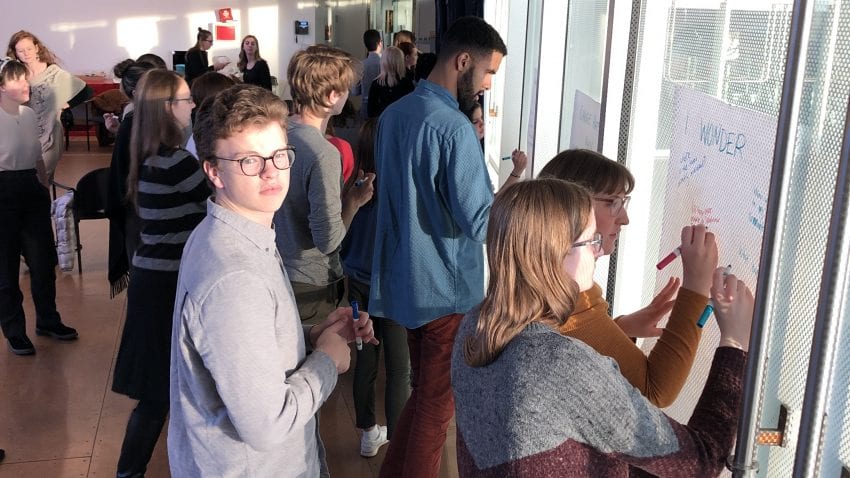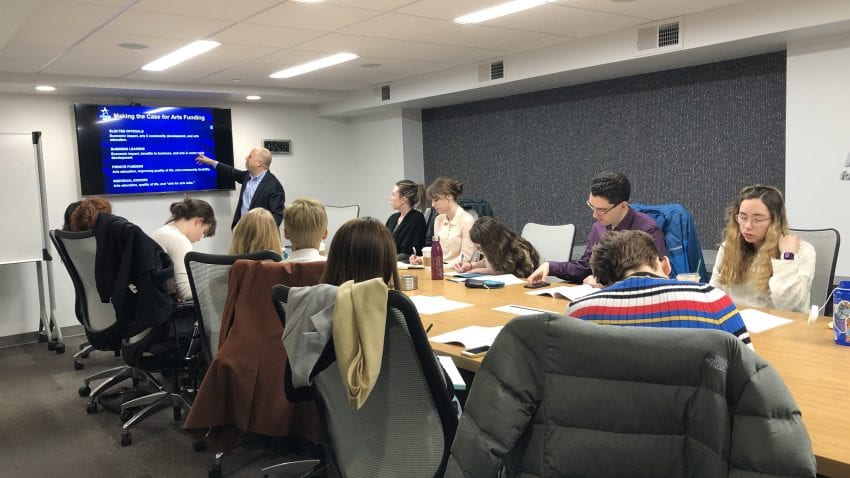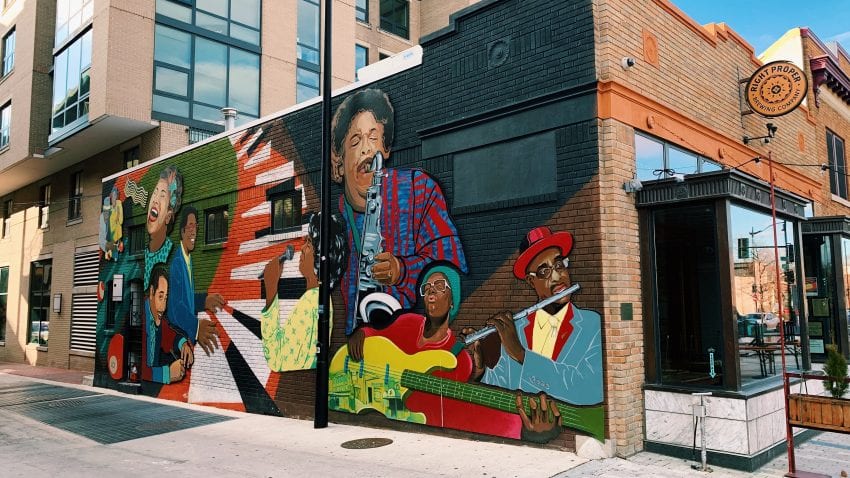Washington D.C. has been an experience beyond description. It is hard to explain how this course has and will continue to impact me as I process all the amazing opportunities we had here. Not only am I far more informed on the connections between democracy and the arts, but I’ve made friends with people whose company I never thought I’d love as I do now. I hope that I’ll continue to reflect on this experience and grow from the many concepts I have learned about. I have been delighted to explore the reaches of civic engagement and advocacy, the diverse history of D.C. arts and culture, and of course the involvement of democratic principles in the production and consumption of art.
When I first heard about this course, I was surprised to hear about its focus on arts, as I had never really thought of Washington, D.C. as a hub for art, but I quickly found otherwise. Besides its rich political history, D.C. is full of diverse communities, all with their own stories. I’ve always believed that art was inherently important, but it has been enlightening to see how art can bring these communities together. The Atlas Performing Arts Center, located on H Street, was a movie theater destroyed in the riots of 1968, but has since been transformed into a bubbling arts center home to several theaters and performance spaces. Now the Atlas identifies itself as a cultural anchor in the H Street community. The theater attempts to bring in patrons from the neighborhood, appealing to them with relatable programming that can be educational, inspiring, and powerful. The Atlas also has classes and allows local arts organizations to perform and practice in its space. Not to mention that its productions and events bring people out of their homes and into local businesses. Arena Stage, another D.C. theater, also has a progressive theater program that allows local youth to create their own productions of their own experiences or thoughts. Art projects like their Voices of Now program can give people of all kinds the opportunity to voice their feelings and opinions in safe spaces, and audience members have get to see and hear perspectives they may have never thought of before.

Students doing an activity like Arena Stage’s Voices of Now program.
I originally did not see how democracy and art were entwined, but Democracy and the Arts, D.C. has certainly led me to better understand the complicated intersection of democracy and the arts. Democracy is built upon listening to the voice of the people, and art and community engagement should start with the same foundation. In many ways, art presentations act as a mini democracy, with who gets to choose what programs are produced, who would come, and how they can be paid for. Internally, many arts organization function like a representative democracy, with elected boards, public contributions, and political conversations. Our democratic government also plays a large role in arts production in Washington D.C. and all over the country. The government funds the National Endowment for the Arts and Humanities, both of which grant funding to arts organizations and projects. However, one should note that the endowments feel the pressure to fund works they think are appropriate to the American people, so as to avoid controversy and maintain their congressionally funded budget. In addition, the United States also has organizations and agencies dedicated to arts education, such as the Arts Education Partnership. Lobbying groups, such as Americans for the Arts, which advocates for arts funding in the U.S., also exist as a part of a functioning democracy.

Meeting with Americans for the Arts.
Democracy also involves having a voice in your community, whether its on the local or federal scale. Through our many site visits and interviews with community and organization leaders, I have had a chance to truly examine what it means to be engaged with a community; something that is far more nuanced than I had once thought. Civic engagement is often applied in many ways and can have a broad spectrum of impacts. Many of the organizations we met with over this past month, have claimed that they strive to be “community anchors,” suggesting they believe they are necessary in keeping their community’s vibrancy or culture through events, outreach, education programs, and performances. However, as positive as civic engagement efforts can be, their results are not always as beneficial as they hope to be.
Gentrification is certainly a hot topic in D.C., referring to the rapid development often associated with bringing a community or region to “middle-class” or idealized standards, but it was mostly unfamiliar to me at the start of this course. In Washington D.C., gentrification has impacted some communities for the worse. Rapid development has driven local businesses and people out of their homes as rising rent and housing costs make it more and more difficult to live there. [1] Unfortunately, this displacement can result in the loss of culture and identity of an area, which we have seen happen in the parts of D.C. that have recovered from the destruction of the ’68 riots, some of which have been completely transformed. [2] Until this trip, the riots in D.C. following Martin Luther King’s assassination were mostly unknown to me, but I quickly learned their important role in Washington D.C.’s rich history. However, it was surprising to learn about how the recovery of these areas resulted in gentrification. The Attucks Adams tour, which highlighted the history and art of Black Broadway and U Street gave us a hand-on understanding of what gentrification looks like. Other arts organizations mentioned how important it was for them to be conscious of their effects on the community, both positive and negative. At Halcyon Arts Lab, arts manager Aisha White communicated how she was careful to make sure that their fellows interact with the community in a way that doesn’t facilitate gentrification, referencing how large public arts projects can bring life to the community, but also sometimes lead to increased property values and their effects on low-income inhabitants. From our interaction with White and other organization leaders, I have learned that in my own civic engagement ideas, it is extremely necessary that I listen to the community I’m trying to make change in, to ensure that their values and ideas are being carried out in the projects I may be pursuing. However, sometimes civic engagement can be as simple and impactful as voting in local elections and being aware and involved in your local community.

Mural from Attucks Adams walking tour
Outside of the valuable knowledge gained from meeting with the many business and non-profit leaders, it was also useful to see how different career paths can be in the real world. As college students and people soon moving on to find jobs in society, it was beneficial to hear that our interviewees had come from many diverse majors and career backgrounds, some inside and some outside the arts field. For me, and many of my peers, it can be rather overwhelming to consider having our entire career paths planned out and ready by the time we graduate. From speaking with people working within the bureaucracy, we learned that such a career can satisfy our needs to feel like we’re doing something to better our world and make a difference, but there are also many other ways to work towards that goal, such as working for a non-profit, museum, or as an artist. We have learned that it is not necessary to work for the government to make a difference in our communities. Yet seeing the impact we can have has activated each of us as instruments of social change. For me, wandering around the Senate buildings was a prime moment for seeing how easy it is to interact with our elected officials. We were able to drop in and meet with them or their staff members at any time. As consumers of news and media, it is easy to put our elected representatives on a pedestal as almost celebrities, we idolize them and tend to think of them as more than human in some ways, but being in their offices made me feel connected to them as people and connected to our democratic government in an entirely new way.

Picture with Senator Tina Smith in Senate Building.
From my growth throughout this course, one conclusion that I have came to is that art is messy, but democracy can be just as messy. Both democracy and art are built on the backs of people’s voices. At their purest, both strive to represent people of all backgrounds, but people can be complicated, and their ideas, even more complicated. We are all products of our experiences, and those can be very different. The people, places, actions, and pursuits we have experienced greatly affect how we feel about political issues, but also how we view and understand works of art. From some of our latter discussions in the course, the differences between each of our thoughts were highlighted, but in an amazing way. Despite coming from all over the country, studying many different majors, and living far different lives, our class found a way to hear and at least attempt to respectfully understand each other’s vastly different opinions, and if Americans, like us, can open their minds and have a little compassion to hear each other out, I’m confident this country can move in the right direction.
[1] Washington Post, https://www.washingtonpost.com/local/in-the-district-gentrification-means-widespread-displacement-report-says/2019/04/26/950a0c00-6775-11e9-8985-4cf30147bdca_story.htm
[2] https://www.bizjournals.com/washington/news/2018/03/30/dc-riots-1968-then-and-now.html
